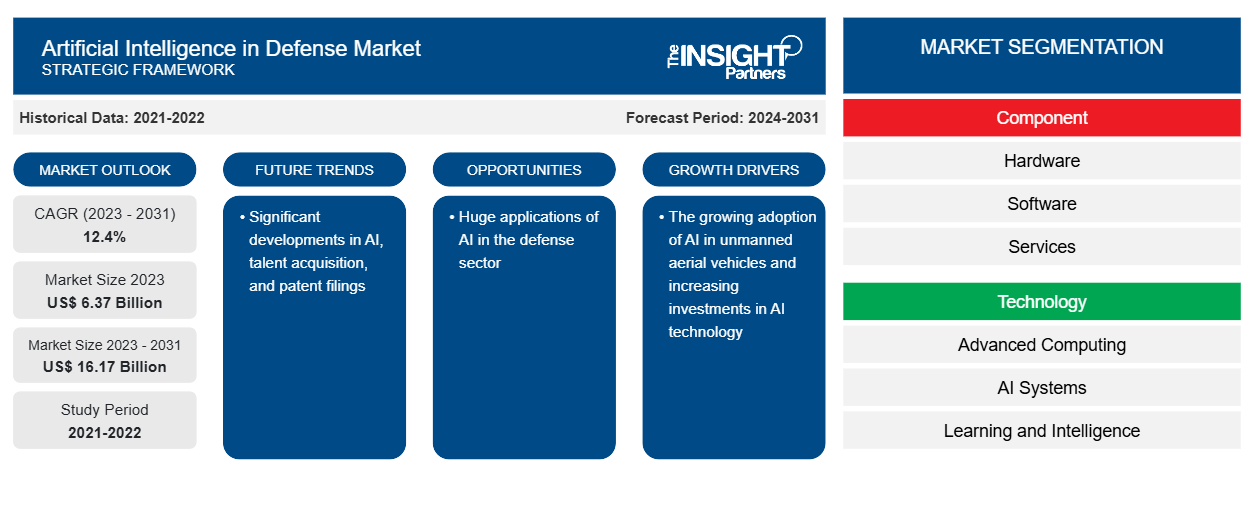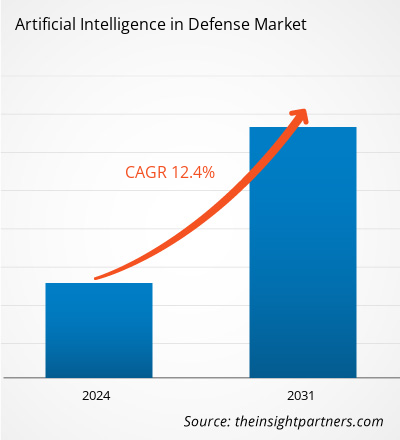The artificial intelligence in defense market size is projected to reach US$ 16.17 billion by 2031 from US$ 6.37 billion in 2023. The market is expected to register a CAGR of 12.4% during 2023–2031. Significant developments in AI, talent acquisition, and patent filings are likely to remain a key trend in the market.
Artificial Intelligence in Defense Market Analysis
Over the past few years, artificial intelligence in the defense market has witnessed huge growth owing to factors such as the growing adoption of AI in unmanned aerial vehicles and increasing investments in AI technology. Huge applications of AI in the defense sector provide lucrative growth opportunities for artificial intelligence in the defense market.
Artificial Intelligence in Defense Market Overview
Artificial intelligence in defense refers to the integration of advanced technologies with defense equipment to increase its efficiency and applications. In several developed countries, the defense sector receives investments from the government. For instance, according to SIPRI, the US military expenditure increased to US$ 876.9 billion in 2022 from US$ 806.2 billion in 2021. These investments are used in the research and development of new technologies and for developing advanced equipment that can be used during battles or wars. Artificial intelligence equipped with defense systems is capable of handling large volumes of data efficiently. In addition, these systems have improved self-regulation and self-control due to their enhanced computing and decision-making capabilities. Further, autonomous weapon platforms use computer vision technology to identify and track objects. Artificial intelligence can help in the extraction of useful information from the equipment, including radars and automatic identification systems. Therefore, upgrading defense weapons, tools, and equipment with the latest technologies is driving artificial intelligence in defense market growth.
Customize This Report To Suit Your Requirement
You will get customization on any report - free of charge - including parts of this report, or country-level analysis, Excel Data pack, as well as avail great offers and discounts for start-ups & universities
Artificial Intelligence in Defense Market: Strategic Insights

- Get Top Key Market Trends of this report.This FREE sample will include data analysis, ranging from market trends to estimates and forecasts.
You will get customization on any report - free of charge - including parts of this report, or country-level analysis, Excel Data pack, as well as avail great offers and discounts for start-ups & universities
Artificial Intelligence in Defense Market: Strategic Insights

- Get Top Key Market Trends of this report.This FREE sample will include data analysis, ranging from market trends to estimates and forecasts.
Artificial Intelligence in Defense Market Drivers and Opportunities
Growing Adoption of AI in Unmanned Aerial Vehicles to Favor Market
Unmanned aerial vehicles (UAVs) have undergone a revolutionary transformation with the adoption of artificial intelligence (AI). Unmanned aerial vehicles (UAVs) integrated with AI allows them to process vast amounts of data in real time, make decisions, and adapt to changing environments without direct human operator intervention. AI-powered UAVs are equipped with sensors and computer vision capabilities for object detection and autonomous navigation. AI in UAVs has opened up new horizons in applications such as surveillance, search and rescue missions, and defense operations. Thus, the growing adoption of AI in unmanned aerial vehicles will drive market growth.
Huge Applications of AI in The Defence Sector
Artificial intelligence (AI) is transforming the defense industry by driving innovations in safety, efficiency, and decision-making. AI-based technology in the defense sector is widely used for many applications such as training, logistics, surveillance, UAV, cybersecurity, advanced military weaponry like LAWS, autonomous combat vehicles & robots. Thus, defense companies are increasingly leveraging artificial intelligence technology to innovate and enhance their operations.
Artificial Intelligence in Defense Market Report Segmentation Analysis
Key segments that contributed to the derivation of the artificial intelligence in defense market analysis are components, technology, platforms, and applications.
- Based on the component, the artificial intelligence in the defense market is divided into hardware, software, and services. The software segment will hold a significant market share in 2023.
- By technology, the market is segmented into advanced computing, AI systems, learning and intelligence. The AI systems segment is further subsegmented into TETRA, DMR, P25, and others. The digital segment is expected to hold a significant market share in 2023.
- In terms of platform, the market is segmented into land, air, and naval. The air segment is expected to hold a significant market share in 2023.
- In terms of application, the market is segmented into cyber security, battlefield healthcare, logistics & transportation, warfare platforms, and others. The warfare platform segment is expected to hold a significant market share in 2023.
Artificial Intelligence in Defense Market Share Analysis by Geography
The geographic scope of the artificial intelligence in defense market report is mainly divided into five regions: North America, Asia Pacific, Europe, Middle East & Africa, and South & Central America.
The North America Artificial Intelligence In Defense Market is segmented into the US, Canada, and Mexico. Ongoing advancements in artificial intelligence (AI) are presenting both exciting prospects and new hurdles for national security agencies. AI, which often coincides with the Fourth Industrial Revolution, has been driving scientific and technical innovations in North America. Military authorities in the US and Canada believe that technology has the potential to significantly alter the way military operations are carried out. For instance, the Pentagon's Defense Advanced Research Projects Agency (DARPA) has been exploring artificial intelligence (AI) to manage drones carrying military weapons and equipment to counter-strike enemies, as drone missions in the US that involve lethal force need human monitoring and supervision.
Artificial Intelligence in Defense Market Regional Insights
The regional trends and factors influencing the Artificial Intelligence in Defense Market throughout the forecast period have been thoroughly explained by the analysts at The Insight Partners. This section also discusses Artificial Intelligence in Defense Market segments and geography across North America, Europe, Asia Pacific, Middle East and Africa, and South and Central America.
Artificial Intelligence in Defense Market Report Scope
| Report Attribute | Details |
|---|---|
| Market size in 2023 | US$ 6.37 Billion |
| Market Size by 2031 | US$ 16.17 Billion |
| Global CAGR (2023 - 2031) | 12.4% |
| Historical Data | 2021-2022 |
| Forecast period | 2024-2031 |
| Segments Covered |
By Component
|
| Regions and Countries Covered | North America
|
| Market leaders and key company profiles |
|
Artificial Intelligence in Defense Market Players Density: Understanding Its Impact on Business Dynamics
The Artificial Intelligence in Defense Market is growing rapidly, driven by increasing end-user demand due to factors such as evolving consumer preferences, technological advancements, and greater awareness of the product's benefits. As demand rises, businesses are expanding their offerings, innovating to meet consumer needs, and capitalizing on emerging trends, which further fuels market growth.

- Get the Artificial Intelligence in Defense Market top key players overview
Artificial Intelligence in Defense Market News and Recent Developments
The artificial intelligence in the defense market is evaluated by gathering qualitative and quantitative data post primary and secondary research, which includes important corporate publications, association data, and databases. A few of the developments in the artificial intelligence in the defense market are listed below:
- Airbus Defence and Space and Helsing, Europe’s leading defense AI and software company, signed a framework cooperation agreement at the ILA aerospace trade show in Berlin. According to the agreement, the companies will work together on artificial intelligence (AI) technologies which will be used in a future Wingman system. (Source: Airbus Defence, Press Release, June 2024)
- Lockheed Martin Skunk Works partnered with the University of Iowa's Operator Performance Laboratory (OPL) to demonstrate the use of artificial intelligence (AI) in air-to-air intercept scenarios. (Source: Lockheed Martin, Press Release, June 2024)
Artificial Intelligence in Defense Market Report Coverage and Deliverables
The “Artificial Intelligence in Defense Market Size and Forecast (2021–2031)” report provides a detailed analysis of the market covering below areas:
- Artificial intelligence in defense market size and forecast at global, regional, and country levels for all the key market segments covered under the scope
- Artificial intelligence in defense market trends, as well as market dynamics such as drivers, restraints, and key opportunities
- Detailed PEST/Porter’s Five Forces and SWOT analysis
- Artificial intelligence in defense market analysis covering key market trends, global and regional framework, major players, regulations, and recent market developments
- Industry landscape and competition analysis covering market concentration, heat map analysis, prominent players, and recent developments for the artificial intelligence in the defense market
- Detailed company profiles
Frequently Asked Questions
What would be the estimated value of the artificial intelligence in defense market by 2031?
Which region dominated the artificial intelligence in defense market in 2023?
Which are the leading players operating in artificial intelligence in the defense market?
What are the future trends of artificial intelligence in the defense market?
What are the driving factors impacting global artificial intelligence in the defense market?
What is the expected CAGR of artificial intelligence in the defense market?
- Historical Analysis (2 Years), Base Year, Forecast (7 Years) with CAGR
- PEST and SWOT Analysis
- Market Size Value / Volume - Global, Regional, Country
- Industry and Competitive Landscape
- Excel Dataset
Recent Reports
Testimonials
Reason to Buy
- Informed Decision-Making
- Understanding Market Dynamics
- Competitive Analysis
- Identifying Emerging Markets
- Customer Insights
- Market Forecasts
- Risk Mitigation
- Boosting Operational Efficiency
- Strategic Planning
- Investment Justification
- Tracking Industry Innovations
- Aligning with Regulatory Trends





















 Get Free Sample For
Get Free Sample For